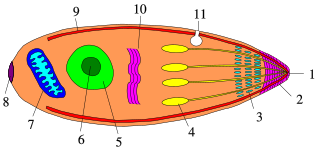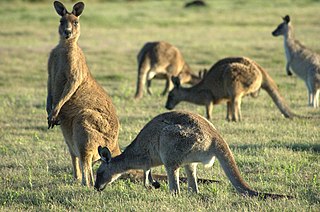Related Research Articles

Toxoplasmosis is a parasitic disease caused by Toxoplasma gondii, an apicomplexan. Infections with toxoplasmosis are associated with a variety of neuropsychiatric and behavioral conditions. Occasionally, people may have a few weeks or months of mild, flu-like illness such as muscle aches and tender lymph nodes. In a small number of people, eye problems may develop. In those with a weak immune system, severe symptoms such as seizures and poor coordination may occur. If a person becomes infected during pregnancy, a condition known as congenital toxoplasmosis may affect the child.

Toxoplasma gondii is a parasitic protozoan that causes toxoplasmosis. Found worldwide, T. gondii is capable of infecting virtually all warm-blooded animals, but felids are the only known definitive hosts in which the parasite may undergo sexual reproduction.

Budding or blastogenesis is a type of asexual reproduction in which a new organism develops from an outgrowth or bud due to cell division at one particular site. For example, the small bulb-like projection coming out from the yeast cell is known as a bud. Since the reproduction is asexual, the newly created organism is a clone and excepting mutations is genetically identical to the parent organism. Organisms such as hydra use regenerative cells for reproduction in the process of budding.

Coccidia (Coccidiasina) are a subclass of microscopic, spore-forming, single-celled obligate intracellular parasites belonging to the apicomplexan class Conoidasida. As obligate intracellular parasites, they must live and reproduce within an animal cell. Coccidian parasites infect the intestinal tracts of animals, and are the largest group of apicomplexan protozoa.
Coccidiosis is a parasitic disease of the intestinal tract of animals caused by coccidian protozoa. The disease spreads from one animal to another by contact with infected feces or ingestion of infected tissue. Diarrhea, which may become bloody in severe cases, is the primary symptom. Most animals infected with coccidia are asymptomatic, but young or immunocompromised animals may suffer severe symptoms and death.

A rhoptry is a specialized secretory organelle. They are club-shaped organelles connected by thin necks to the extreme apical pole of the parasite. These organelles, like micronemes, are characteristic of the motile stages of Apicomplexa protozoans. They can vary in number and shape and contain numerous enzymes that are released during the process of host penetration. The proteins they contain are important in the interaction between the host and the parasite, including the formation of the parasitophorous vacuole (PV).
An obligate parasite or holoparasite is a parasitic organism that cannot complete its life-cycle without exploiting a suitable host. If an obligate parasite cannot obtain a host it will fail to reproduce. This is opposed to a facultative parasite, which can act as a parasite but does not rely on its host to continue its life-cycle. Obligate parasites have evolved a variety of parasitic strategies to exploit their hosts. Holoparasites and some hemiparasites are obligate.

Toll-like receptor 11 (TLR11) is a protein that in mice and rats is encoded by the gene TLR11, whereas in humans it is represented by a pseudogene. TLR11 belongs to the toll-like receptor (TLR) family and the interleukin-1 receptor/toll-like receptor superfamily. In mice, TLR11 has been shown to recognise (bacterial) flagellin and (eukaryotic) profilin present on certain microbes, it helps propagate a host immune response. TLR11 plays a fundamental role in both the innate and adaptive immune responses, through the activation of Tumor necrosis factor-alpha, the Interleukin 12 (IL-12) response, and Interferon-gamma (IFN-gamma) secretion. TLR11 mounts an immune response to multiple microbes, including Toxoplasma gondii, Salmonella species, and uropathogenic E. coli, and likely many other species due to the highly conserved nature of flagellin and profilin.

Fish fulfill several criteria proposed as indicating that non-human animals experience pain. These fulfilled criteria include a suitable nervous system and sensory receptors, opioid receptors and reduced responses to noxious stimuli when given analgesics and local anaesthetics, physiological changes to noxious stimuli, displaying protective motor reactions, exhibiting avoidance learning and making trade-offs between noxious stimulus avoidance and other motivational requirements.

Apicomplexans, a group of intracellular parasites, have life cycle stages that allow them to survive the wide variety of environments they are exposed to during their complex life cycle. Each stage in the life cycle of an apicomplexan organism is typified by a cellular variety with a distinct morphology and biochemistry.
Hammondia is a genus of parasitic alveolates in the phylum Apicomplexa.

Cats are a popular pet in New Zealand. Cat ownership is occasionally raised as a controversial conservation issue due to the predation of endangered species, such as birds and lizards, by feral cats.
Behavior-altering parasites are parasites with two or more hosts, capable of causing changes in the behavior of one of their hosts to enhance their transmission, sometimes directly affecting the hosts' decision-making and behavior control mechanisms. They do this by making the intermediate host, where they may reproduce asexually, more likely to be eaten by a predator at a higher trophic level which becomes the definitive host where the parasite reproduces sexually; the mechanism is therefore sometimes called parasite increased trophic facilitation or parasite increased trophic transmission. Examples can be found in bacteria, protozoa, viruses, and animals. Parasites may also alter the host behaviour to increase protection of the parasites or their offspring; the term bodyguard manipulation is used for such mechanisms.
Hammondia hammondi is a species of obligate heteroxenous parasitic alveolates of domestic cats. Intracellular cysts develop mainly in striated muscle. After the ingestion of cysts by cats, a multiplicative cycle precedes the development of gametocytes in the epithelium of the small intestine. Oocyst shedding persists for 10 to 28 days followed by immunity. Cysts in skeletal muscle measure between 100 and 340 μm in length and 40 and 95 μm in width. Some of the intermediate hosts develop low levels of antibody and some cross-immunity against Toxoplasma.

Welfare biology is a proposed cross-disciplinary field of research to study the positive and negative well-being of sentient individuals in relation to their environment. Yew-Kwang Ng first advanced the field in 1995. Since then, its establishment has been advocated for by a number of writers, including philosophers, who have argued for the importance of creating the research field, particularly in relation to wild animal suffering. Some researchers have put forward examples of existing research that welfare biology could draw upon and suggested specific applications for the research's findings.

The ethics of uncertain sentience refers to questions surrounding the treatment of and moral obligations towards individuals whose sentience—the capacity to subjectively sense and feel—and resulting ability to experience pain is uncertain; the topic has been particularly discussed within the field of animal ethics, with the precautionary principle frequently invoked in response.
Catia Faria is a Portuguese moral philosopher and activist for animal rights and feminism. She is assistant professor in Applied Ethics at the Complutense University of Madrid, and is a board member of the UPF-Centre for Animal Ethics. Faria specialises in normative and applied ethics, especially focusing on how they apply to the moral consideration of non-human animals. In 2022, she published her first book, Animal Ethics in the Wild: Wild Animal Suffering and Intervention in Nature.
Octopus bocki is a species of octopus, which has been located near south Pacific islands such as Fiji, the Philippines, and Moorea and can be found hiding in coral rubble. They can also be referred to as the Bock's pygmy octopus. They are nocturnal and use camouflage as their primary defense against predators as well as to ambush their prey. Their typical prey are crustaceans, crabs, shrimp, and small fish and they can grow to be up to 10cm in size.

Jonathan Birch is a British philosopher who is an Associate Professor in the Department of Philosophy Logic and Scientific Method at the London School of Economics and Political Science. His work addresses the philosophy of biology, especially questions around the evolution of social behaviour and social norms, animal sentience, and animal welfare.

Nishith Gupta is an Indian-German molecular biologist and parasitologist known for his pioneering work in the field of Host–pathogen interaction and cell signalling. He is currently working as Professor, Senior Fellow of the Wellcome Trust-DBT and Head of the Department of Biological Sciences at the Hyderabad campus of Birla Institute of Technology and Science, Pilani.
References
- ↑ Courtet, Philippe, ed. (2016). Understanding Suicide. Cham: Springer International Publishing. doi:10.1007/978-3-319-26282-6. ISBN 978-3-319-26280-2.
- ↑ Peña-Guzmán, David M. (2017-01-01). "Can nonhuman animals commit suicide?". Animal Sentience. 2 (20). doi: 10.51291/2377-7478.1201 . ISSN 2377-7478. S2CID 56436713.
- 1 2 Preti, Antonio (December 2007). "Suicide among Animals: A Review of Evidence". Psychological Reports. 101 (3): 831–848. doi:10.2466/pr0.101.3.831-848. ISSN 0033-2941. PMID 18232440. S2CID 40423383.
- ↑ Preti, Antonio (January 2011). "Do Animals Commit Suicide? Does It Matter?". Crisis. 32 (1): 1–4. doi:10.1027/0227-5910/a000077. ISSN 0227-5910. PMID 21371964.
- ↑ Abnormal behavior in animals. Michael W. Fox. Philadelphia: Saunders. 1968. ISBN 0-7216-3825-2. OCLC 301659067.
{{cite book}}: CS1 maint: others (link) - 1 2 3 Shorter, J. R.; Rueppell, O. (February 2012). "A review on self-destructive defense behaviors in social insects". Insectes Sociaux. 59 (1): 1–10. doi:10.1007/s00040-011-0210-x. ISSN 0020-1812. S2CID 13257903.
- ↑ Moore, Janice (April 1984). "Altered Behavioral Responses in Intermediate Hosts -- An Acanthoceptalan Parasite Strategy". The American Naturalist. 123 (4): 572–577. doi:10.1086/284224. ISSN 0003-0147. S2CID 86700440.
- ↑ Reggente, Melissa A. L.; Alves, Filipe; Nicolau, Cátia; Freitas, Luís; Cagnazzi, Daniele; Baird, Robin W.; Galli, Paolo (2016-09-27). "Nurturant behavior toward dead conspecifics in free-ranging mammals: new records for odontocetes and a general review". Journal of Mammalogy. 97 (5): 1428–1434. doi: 10.1093/jmammal/gyw089 . ISSN 0022-2372.
- ↑ Malkesman, Oz; et al. (April 2009). "Animal Models of Suicide Trait-Related Behaviors". Trends in Pharmacological Sciences. 30 (4): 165–173. doi:10.1016/j.tips.2009.01.004. PMC 2788815 . PMID 19269045.
- 1 2 Preti, Antonio (June 2011). "Animal model and neurobiology of suicide". Progress in Neuro-Psychopharmacology and Biological Psychiatry. 35 (4): 818–830. doi:10.1016/j.pnpbp.2010.10.027. PMID 21354241. S2CID 3459576.
- ↑ Lester, David (2017-01-01). "Non-human animal suicide could be tested". Animal Sentience. 2 (20). doi: 10.51291/2377-7478.1286 . ISSN 2377-7478.
- ↑ Comai, Stefano; Gobbi, Gabriella (2016), Courtet, Philippe (ed.), "Translational Research in Suicide: Is It Possible to Study Suicide in Animal Models?", Understanding Suicide, Cham: Springer International Publishing, pp. 177–188, doi:10.1007/978-3-319-26282-6_14, ISBN 978-3-319-26280-2 , retrieved 2021-10-23
- ↑ Melissa Hogenboom. "Many-animals-seem-to-kill-themselves-but-it-is-not-suicide". BBC.Or see: http://www.bbc.com/earth/story/20160705-many-animals-seem-to-kill-themselves-but-it-is-not-suicide
- 1 2 3 O'Hanlon, Larry (10 March 2010). "Animal Suicide Sheds Light on Human Behavior". Discovery News. Archived from the original on 26 March 2015. Retrieved 16 August 2013.
- ↑ Maudsley, Henry (July 1879). "Alleged Suicide of a Dog". Mind. 4 (15): 410–413.
- 1 2 Palmer, Brian (16 November 2011). "Hairy-Kiri: Do animals commit suicide". Slate. Retrieved 16 August 2013.
- ↑ Nobel, Justin (2010-03-19). "Do Animals Commit Suicide? A Scientific Debate". Time. ISSN 0040-781X . Retrieved 2017-01-26.
- ↑ Peña-Guzmán, David (2017-01-01). "Can nonhuman animals commit suicide?". Animal Sentience. 2 (20). doi: 10.51291/2377-7478.1201 . ISSN 2377-7478.
- ↑ Riley, Christopher (2014-06-08). "The dolphin who loved me: the Nasa-funded project that went wrong". The Observer. ISSN 0029-7712 . Retrieved 2020-11-04.
- ↑ "The Girl Who Talked to Dolphins". BBC Four. Retrieved 2018-04-16.
- ↑ History of Animals, Book 9, Chapter 34 (page 274).
- ↑ Maschwitz, Ulrich; Maschwitz, Eleonore (1974). "Platzende Arbeiterinnen: Eine neue Art der Feindabwehr bei sozialen Hautflüglern". Oecologia (in German). 14 (3): 289–294. Bibcode:1974Oecol..14..289M. doi:10.1007/BF01039798. PMID 28308625. S2CID 23644298.
- ↑ C. Bordereau; A. Robert; V. Van Tuyen; A. Peppuy (1997). "Suicidal defensive behavior by frontal gland dehiscence in Globitermes sulphureus Haviland soldiers (Isoptera)". Insectes Sociaux . 44 (3): 289–297. doi:10.1007/s000400050049. S2CID 19770804.
- ↑ Jones, T. H.; Clark, D. A.; Edwards, A. A.; Davidson, D. W.; Spande, T. F.; Snelling, R. R. (2004). "The Chemistry of Exploding Ants, Camponotus SPP. (Cylindricus COMPLEX)". Journal of Chemical Ecology. 30 (8): 1479–1492. Bibcode:2004JCEco..30.1479J. doi:10.1023/B:JOEC.0000042063.01424.28. ISSN 0098-0331. PMID 15537154. S2CID 23756265.
- ↑ Hermann, Henry R. (June 1971). "Sting autotomy, a defensive mechanism in certain social Hymenoptera". Insectes Sociaux. 18 (2): 111–120. doi:10.1007/bf02223116. ISSN 0020-1812. S2CID 42293043.
- ↑ Urban Bee Gardens Archived 2010-05-01 at the Wayback Machine Urban Bee Legends – by Jaime Pawelek
- ↑ Clough, Garrett C. (1965). "Lemmings and Population Problems". American Scientist. 53 (2): 199–212. ISSN 0003-0996. JSTOR 27836007.
- ↑ Moore, Janice (April 1984). "Altered Behavioral Responses in Intermediate Hosts – An Acanthoceptalan Parasite Strategy". The American Naturalist. 123 (4): 572–577. doi:10.1086/284224. ISSN 0003-0147. S2CID 86700440.
- ↑ Shaoni Bhattacharya (August 31, 2005). "Parasites brainwash grasshoppers into death dive". New Scientist .
- ↑ F. Thomas; A. Schmidt-Rhaesa; G. Martin; C. Manu; P. Durand; F. Renaud (May 2002). "Do hairworms (Nematomorpha) manipulate the water seeking behaviour of their terrestrial hosts?". Journal of Evolutionary Biology . 15 (3): 356–361. CiteSeerX 10.1.1.485.9002 . doi:10.1046/j.1420-9101.2002.00410.x. S2CID 86278524.[ permanent dead link ]
- ↑ Webster, JP; McConkey, GA (June 2010). "Toxoplasma gondii-altered host behaviour: clues as to mechanism of action". Folia Parasitologica. 57 (2): 95–104. doi: 10.14411/fp.2010.012 . PMID 20608471.
- ↑ Webster, J. P. (2007). "The Effect of Toxoplasma gondii on Animal Behavior: Playing Cat and Mouse". Schizophrenia Bulletin. 33 (3): 752–756. doi:10.1093/schbul/sbl073. PMC 2526137 . PMID 17218613.
- ↑ Berdoy, M.; Webster, J. P.; Macdonald, D. W. (2000). "Fatal Attraction in Rats Infected with Toxoplasma gondii". Proceedings: Biological Sciences. 267 (1452): 1591–1594. doi:10.1098/rspb.2000.1182. ISSN 0962-8452. JSTOR 2665707. PMC 1690701 . PMID 11007336.
- ↑ Trail, Deborah R. Smith (1980). "Behavioral Interactions between Parasites and Hosts: Host Suicide and the Evolution of Complex Life Cycles". The American Naturalist. 116: 77–91. doi:10.1086/283612. hdl: 1808/17548 . S2CID 16777324.
- ↑ Swennen, Ching (1974). "Observations on the trematode parvatrema affinis, causative agent of crawling tracks of macoma balthica". Netherlands Journal of Sea Research. 8 (1): 108–115. Bibcode:1974NJSR....8..108S. doi:10.1016/0077-7579(74)90029-5.
- ↑ "18 Facts About The Tarsier: Suicidal Monkey of Philippines!". Man vs Clock. 14 December 2022. Retrieved 18 June 2023.
- ↑ Bales, Bob (11 November 2022). "The Heartbreaking Story Of The Philippine Tarsier Of Bohol: And Why They Commit Suicide". The Traveling Fool. Retrieved 18 June 2023.
- ↑ "Spectral Tarsier – Why are Tarsiers Suicidal?". Primates Park. 20 March 2022. Retrieved 18 June 2023.
- ↑ Mudditt, Jessica (16 April 2018). "Inside the Mystery of Animal 'Suicide'". VICE. Retrieved 18 June 2023.
- ↑ "Philippine Tarsiers, the Suicidal Primates". Treehugger. 7 March 2012. Retrieved 18 June 2023.
- ↑ Lederer, Muriel. "Return of the Pied Piper". The American Mercury , Dec. 1953, pp. 33–4.
- ↑ Blum, Geoffrey. 1996. "One Billion of Something", in: Uncle Scrooge Adventures by Carl Barks, #9.
- ↑ "Did Disney Fake Lemming Deaths for the Nature Documentary 'White Wilderness'?". Snopes.com. 27 February 1996.
- ↑ Cooke, Tim (25 April 2017). "What does Werner Herzog's nihilist penguin teach us about life?". Little White Lies . Retrieved 28 December 2022.
- ↑ Potts, Mary Anne (22 July 2008). "Herzogian Antarctica: Pink Floyd Seals and a Suicidal Penguin". National Geographic . Archived from the original on December 28, 2022. Retrieved 28 December 2022.